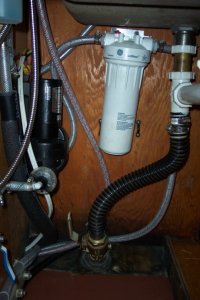Ceramic Filters and Cholrine
We used 1/4 cup chlorox tm for each of our 60 gallon tanks. You would not want to drink the water, but it did a good job of sanatizing them. Fill them 1/2 full or so with water, add the chlorox, and then fill completely, then go sailing, then come back and pump the tanks completely dry, then fill with fresh water, put in the filter and have a great season.
The ceramic filters would be great for the lakes, as they are water purification devices, and remove taste, odor, bacteria, and some viruses even. However they are Expensive it they are good, and have a low flow rate, so you would want to have a filter fo the general use water, and one of the ceremacs for drinking cooking, and final rinse on the dishes. I would put it in series after the primary filtration system to make it last longer.
Tanks -> Pump -> * Primary Filter => Ceramic Filter ->Drinking water outlet etc.
* Primary Filter-> Rest of boat Faucets etc.
Oh watermakers in fresh water are interesting, they work but you have to run them at significant reduced pressure, and there are still official cases of membrane damage after doing so. A better bet would be one of the Ceramic filters like we are discussing here.
Guy

Guy


